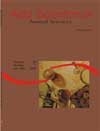<b>Effect of feedlot orientation and shading on haircoat surface temperature of cattle</b> - DOI: 10.4025/actascianimsci.v30i2.4702
Keywords:
genetic group, building orientation, radiation, shading
Abstract
The study evaluated the effect of shading on haircoat surface temperature (HST) of cattle from five genetic groups: 4 ½ Limousin + ½ Nellore (L), 8 ½ Limousin + ¼ Nellore + ¼ RedAngus (LR), 4 ½ Limousin + ¼ Nellore + ¼ Simmental (LS), 2 ½ Marchigiana + ¼ Nellore + ¼ Simmental (MS) and 4 ¾ RedAngus + ¼ Nellore + ¼ Guzerá (RG). The cattle were 20 months old and had an average weight of 300 kg. They were housed at individual 10 m2-pens, with half covered with zinc tiles. The diet was isoproteic and isoenergetic, with a 67:33 roughage concentrate ratio. There was no difference (p > 0.05) in HST among genetic groups during daytime on Side 1 (S1) of the feedlot, while on Side 2 (S2) the lowest HST (29.48oC) (p < 0.05) was observed for MS. At night, the HST for Side 1 was higher (p < 0.05) for RG (30.32oC) and did not differ (p > 0.05) among the others. On Side 2, the highest HST (p < 0.05) occurred for RG (30.63oC) and the lowest (p < 0.05) for MS (28.07oC). The building orientation showed no effect on HST of animals, which was influenced by time of day, direct reflex action of thermal radiation intensity on zinc tiles and on the concrete floor.Downloads
Download data is not yet available.
Published
2008-08-07
How to Cite
Kazama, R., Roma, C. F. da C., Barbosa, O. R., Zeoula, L. M., Ducatti, T., & Tesolin, L. C. (2008). <b>Effect of feedlot orientation and shading on haircoat surface temperature of cattle</b> - DOI: 10.4025/actascianimsci.v30i2.4702. Acta Scientiarum. Animal Sciences, 30(2), 211-216. https://doi.org/10.4025/actascianimsci.v30i2.4702
Issue
Section
Animal Production
DECLARATION OF ORIGINALITY AND COPYRIGHTS
- I Declare that current article is original and has not been submitted for publication, in part or in whole, to any other national or international journal.
The copyrights belong exclusively to the authors. Published content is licensed under Creative Commons Attribution 4.0 (CC BY 4.0) guidelines, which allows sharing (copy and distribution of the material in any medium or format) and adaptation (remix, transform, and build upon the material) for any purpose, even commercially, under the terms of attribution.
Read this link for further information on how to use CC BY 4.0 properly.
0.9
2019CiteScore
29th percentile
Powered by 








































